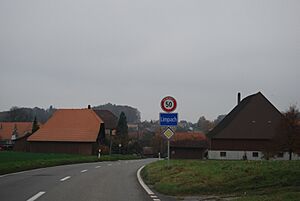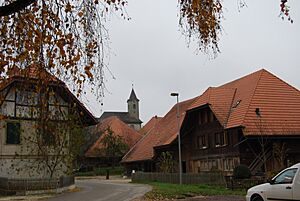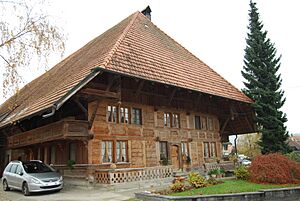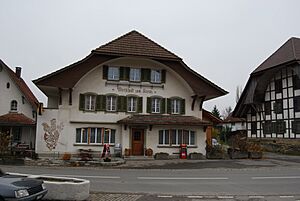Limpach, Switzerland facts for kids
Quick facts for kids
Limpach
|
||
|---|---|---|
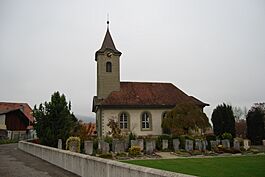
Limpach village Swiss Reformed church
|
||
|
||
| Country | Switzerland | |
| Canton | Bern | |
| District | Bern-Mittelland | |
| Area | ||
| • Total | 4.4 km2 (1.7 sq mi) | |
| Elevation | 473 m (1,552 ft) | |
| Population
(Dec 2011)
|
||
| • Total | 354 | |
| • Density | 80.5/km2 (208.4/sq mi) | |
| Postal code |
3317
|
|
| Surrounded by | Aetingen (SO), Bätterkinden, Büren zum Hof, Fraubrunnen, Mülchi, Schalunen, Unterramsern (SO) | |
Limpach used to be a small town, or municipality, in the Bern-Mittelland area of Bern canton in Switzerland. On January 1, 2014, Limpach and several other towns joined together. They all became part of the larger municipality of Fraubrunnen.
Contents
- What is the history of Limpach?
- Where is Limpach located?
- What does the Limpach coat of arms mean?
- What is the population of Limpach?
- What are Limpach's important heritage sites?
- How does Limpach's economy work?
- What religions are practiced in Limpach?
- What is the education system like in Limpach?
- See also
What is the history of Limpach?
Limpach was first written about in the year 1276. This is the earliest record we have of the town.
Early Settlements and Rulers
Scientists have found old grave mounds, called tumuli, at a place called In Ischlag. These mounds show that people lived in this area a very long time ago.
In the 1200s, both the village and its local court were owned by Fraubrunnen Abbey. An abbey is like a monastery where monks or nuns live. When Bern became Protestant in 1528, they took over the Abbey's lands. This meant Limpach then came under Bern's control.
The village was managed by the Fraubrunnen area. The higher court, which handled more serious cases, was first part of the Counts of Kyburg's lands. In 1406, Bern took over these lands too. Limpach was then placed under the high court in Zollikofen. In 1836, a big fire destroyed parts of the village, but it was rebuilt.
The Village Church
The church in Limpach was also first mentioned in 1276. The original church building was replaced in 1808 with a new one. The right to choose the church's priest, called patronage rights, changed hands many times.
First, a family called Senn von Münsingen owned these rights. They sold them in 1390 to the Schilling family from Solothurn. In 1431, the Schillings traded these rights to a hospital in Solothurn. After Limpach became Protestant, Bern took over the patronage rights in 1539.
Draining the Limpach Valley
The valley around the Limpach river has always been quite marshy. This means it was wet and swampy. People tried to drain the valley for the first time in the 1400s, but it didn't work very well.
Later, in 1746-47 and 1790-91, the first canals were built to help drain the marshes. Between 1939 and 1951, the town, along with the Cantons of Bern and Solothurn, worked on a big project. They wanted to completely drain the valley and make the river flow in a channel. In 1984, two pumping stations were built to help drain the Limpachmoos marsh even more.
Farming and Population Changes
Starting in the 1800s, many farmers in Limpach changed what they grew. Instead of grain, they started raising dairy cattle. The village dairy and cheese factory opened in 1845.
As farming became more modern with machines, fewer people were needed for farm work. This meant there were fewer jobs in the village, and the population started to shrink. Even though some people who worked elsewhere moved to Limpach, the number of people living there kept going down.
In 1982, Limpach, Etzelkofen, and Mülchi created a shared school district. Older students from the village go to school in Fraubrunnen or Messen in Solothurn.
Where is Limpach located?
Before it merged, Limpach covered an area of about 4.4 square kilometers (1.7 square miles). Most of this land, about 70.3%, was used for farming. About 21.8% of the land was covered by forests.
The rest of the land was used for buildings and roads (7.4%). A very small part (0.2%) was rivers or lakes. Most of the built-up area was for houses and other buildings (3.4%), and roads (3.6%). All the forests were dense, heavy forests.
For farming, 63.4% of the land was used for growing crops. Another 5.6% was used for pastures where animals graze. About 1.3% was for orchards or vineyards. All the water in the area is flowing water, like rivers.
Limpach is located in the Limpach valley, right on the border of the Canton of Solothurn. The main church in Limpach also serves the nearby villages of Büren zum Hof and Schalunen.
On December 31, 2009, the old district of Amtsbezirk Fraubrunnen was closed. The next day, January 1, 2010, Limpach became part of the new Verwaltungskreis Bern-Mittelland district.
What does the Limpach coat of arms mean?
The official description of Limpach's coat of arms is: Or on a Bend wavy Azure three Fishes Argent. This means it has a gold background. A wavy blue stripe goes across it, and on this stripe are three silver fish. The wavy blue line on the coat of arms represents the Limpach river.
What is the population of Limpach?
In 2011, Limpach had a population of 354 people. As of 2010, about 5.3% of the people living there were foreign nationals. Over ten years, from 2000 to 2010, the population changed by about 2.7%. More people moved into Limpach (7.8%) than were born there (a decrease of 3.9% from births and deaths).
Most people in Limpach speak German. In 2000, about 99.7% of the population spoke German as their first language. A small number of people spoke Albanian.
In 2008, the population was split evenly, with 50.0% male and 50.0% female. About 47.1% were Swiss men, and 2.9% were non-Swiss men. For women, 47.6% were Swiss, and 2.4% were non-Swiss.
About 38.0% of the people living in Limpach in 2000 were also born there. Another 38.6% were born in the same canton (Bern). About 17.1% were born elsewhere in Switzerland, and 5.1% were born outside of Switzerland.
As of 2010, young people (ages 0–19) made up 22.1% of the population. Adults (ages 20–64) made up 61.2%, and seniors (over 64 years old) made up 16.8%.
In 2000, there were 131 single people in Limpach who had never been married. There were 154 married people, 25 widows or widowers, and 6 divorced people.
Also in 2000, there were 43 households with only one person. There were 15 households with five or more people. Most apartments (93.4%) were lived in all the time. A few (2.2%) were used only at certain times of the year, and 4.4% were empty. In 2010, about 5.9 new homes were built for every 1000 residents.
The chart below shows how Limpach's population has changed over time:

What are Limpach's important heritage sites?
The Swiss Reformed church in Limpach is a very important building. It is listed as a Swiss heritage site of national significance. This means it's a special place that is protected because of its history and culture. The entire old village of Limpach is also part of the Inventory of Swiss Heritage Sites.
How does Limpach's economy work?
In 2011, the unemployment rate in Limpach was very low, at 0.89%. This means almost everyone who wanted a job had one. In 2008, 106 people worked in the town.
Jobs in Different Sectors
- Primary Sector: This includes jobs like farming and fishing. In 2008, 48 people worked in this sector, mostly in agriculture. There were about 15 businesses in this area.
- Secondary Sector: This includes jobs like manufacturing and construction. There were 37 people working here, with 3 businesses. Most of these jobs (34) were in construction.
- Tertiary Sector: This includes service jobs, like shops, restaurants, and schools. There were 21 people working in this sector, with 9 businesses.
Overall, 148 residents of Limpach had jobs. About 40.5% of these workers were female.
Full-time Jobs
In 2008, there were 79 full-time equivalent jobs in Limpach.
- 29 jobs were in the primary sector, all in agriculture.
- 35 jobs were in the secondary sector. Only 1 was in manufacturing, and 34 were in construction.
- 15 jobs were in the tertiary sector. About 4 of these were in sales or car repair. One job was in a hotel or restaurant. Four jobs were for technical experts or scientists, and 3 jobs were in education.
Commuting to Work
In 2000, 32 workers came into Limpach for their jobs. However, 78 workers left Limpach to work in other towns. This means more people left Limpach for work than came in. About 4.7% of workers used public transportation to get to work, and 50.7% used a private car.
What religions are practiced in Limpach?
Based on the 2000 census, most people in Limpach were Christian. About 3.5% were Roman Catholic. A large majority, 85.8%, belonged to the Swiss Reformed Church.
A small number of people (about 6.96%) belonged to other Christian churches. There was also 1 person who was a member of an Orthodox church. About 3.16% of the population followed Islam. Finally, about 2.85% of people did not belong to any church, or were agnostic or atheist. A very small number (0.95%) did not answer the question.
What is the education system like in Limpach?
In Limpach, about 131 people (41.5% of the population) had finished high school, which is called upper secondary education. Another 25 people (7.9%) had gone on to higher education, like a university or a specialized college. Of those with higher education, 72.0% were Swiss men and 20.0% were Swiss women.
Bern's School System
The school system in the Canton of Bern works like this:
- Children start with one year of non-required Kindergarten.
- Then, they go to six years of Primary school.
- After that, they have three years of required lower Secondary school. In this stage, students are grouped based on their abilities.
- After lower Secondary, students can choose to continue their schooling or start an apprenticeship to learn a trade.
Schooling in Limpach
During the 2010-11 school year, 34 students attended classes in Limpach. There were no kindergarten classes in the town itself. Limpach had 2 primary classes with 34 students. For a small number of these primary students (2.9%), their first language was different from the language used in the classroom.
In 2000, 6 students who lived in other towns came to school in Limpach. At the same time, 27 students who lived in Limpach went to schools outside the town.
See also
 In Spanish: Limpach para niños
In Spanish: Limpach para niños





